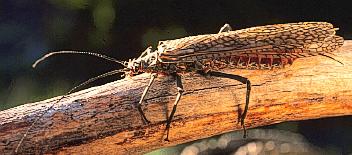Aquatic Invertebrates of Montana
Plecoptera

Introduction
Stoneflies. A small, homogeneous order of with 17 families and about 1900 species worldwide. Nine families and 595 species are neartic. Montana has all 9 neartic families with 113 species, 6th among the states and provinces. Neoptera- Exopterygota- Hemimetabolous.
Recognition
Nymphs- external wingpads present, unmodified chewing mouthparts, tarsi with 2 claws, usually with conspicuous cerci. Adults- 2 pairs of membranous wings held flat over the abdomen (sometimes reduced: apterous- micropterous- brachypterous- macropterous), tarsi 2-3 segmented, antennae conspicuous, cerci usually conspicuous.
Life Cycle
Highly ornamented eggs may hatch quickly or undergo long diapause. The nymphs grow through many instars (12 - 23). The length of the life cycle is 1 to 4 years. Mature nymphs move to shore and climb out of the water (mostly at night) before the final molt. Adults live for a few days to few weeks among shoreline vegetation or rocks and they feed little, if at all. Males attract mates by drumming, and mate while alighted. Females lay the eggs on or above the water. The eggs separate and sink to the bottom.
Trophic Roles
Two major groups; nymphs of Perlidae, Perlodidae and Chloroperlidae are primarily predators (often ferocious ones taking even small salamanders), those of the remaining families primarily shredders-detritivores. Adults of Taeniopterygidae, Nemouridae, Leuctridae and Capniidae may feed on algae, leaves or buds, those of the remaining families seldom feed.
Communities
Frequently complex in cold and cool lotic habitats, with many species, strongly organized altitudinally and seasonally (including winter), and by body size and trophic role. Many species are hyporheic. Many species appear rare. A few species occur in cold lentic and warm lotic waters; none occur in warm lentic water.
Economic Importance
Adult feeding may damage the buds of fruit trees, rarely an emergence nuisance (sometimes in water supplies), sometimes predate fish eggs and fry, important primary and secondary consumers in many streams, fish food, fishing fly patterns, water quality indicators.
Zoogeography
Poor adult dispersal and specific ecological needs of the nymphs restricts their distribution and makes them very useful group (shared species generally indicates vicariance). An ancient group on all continents, but rare on islands and with very limited north-south exchange in the Americas. Recent (pleistocene) episodes of local speciation. Many endemic species (Appalachians and Sierra-Cascades).
Collecting
Adults provide the best species list. These can be hand collected or aspirated from surfaces (for example, concrete bridges), by sweeping streamside vegetation or trapped. Early morning is often the best time. Year-round work is required in most area. Some species in warmer areas come to light. Nymphs of some species are easily taken in benthic collections, others are rare or hyporheic, some are specialized for organic substrates. Some nymphs are most frequently found only as exuviae.
Rearing
Fully mature nymphs (with black wing pads) can usually be reared if kept cool and damp in a Styrofoam cup. The adults fully mature in a couple days.
Preservation
Adults are collected and stored in 70% ethanol. Nymphs are best fixed in Kahle's fluid and transferred to 70% ethanol after a few days.
Taxonomy
Well known with many faunal treatments and revisions available. Currently a popular group receiving much attention, which is resulting in many new discoveries and taxonomic changes. Many current names represent elevations in former ranks. Males, females, eggs, and nymphs are frequently identifiable to species.
Quick recognition of the nymphs of the neartic families
- Carnivores- paraglossa much longer the glossa.
- Perlidae- branched gills on the thorax
- Perlodidae- hind wingpads divergent.
- Chloroperlidae- hind wingpads parallel.
- Shredders- glossa and paraglossa about the same length.
- Pteronarcyidae- branched gills on abdomen
- Peltoperlidae- thoracic sternal plates shieldlike, overlapping.
- Taeniopterygidae- hind wings pads divergent, tarsal segments 1 and 2 subequal.
- Nemouridae- hind wing pads divergent, tarsal segment 2 smaller than 1.
- Capniidae- hind wing pads parallel, pleural fold on AbT1-9T.
- Leuctridae- hind wing pads parallel, pleural fold on AbT1-7T at most.
Key References
- Baumann, R.W., A.R. Gaufin and R.F. Surdick. 1977. The Stoneflies (Plecoptera) of the rocky mountains. Memoirs Amer. Ent. Soc. no. 31.
- Stewart, K.W. and B.P. Stark. 1988. Nymphs of North American stonefly genera (Plecoptera) Entomological Society of America, Thomas Say Foundation Xii. 460pp.
Montana Species list
Reference Update
- Stanger, J. and R.W. Baumann. 1993. A revision of the stonefly genus Taenionema (Plecoptera: Taeniopterygidae). Trans. Amer. Ent. Soc. 119:171-229.
- Campbell, I.C., ed. 1990. Mayflies and stoneflies life histories and biology. Kluwer Academic Publishers, Boston, 366pp.
- Nelson,C.R., and R.W. Baumann. 1987. The winter stonefly genus Capnura (Plecoptera: Capniidae) in North America: Systematics, phylogeny and zoogeography. Trans. Am. Ent. Soc. 113:1-28.
- Stark, B.P., S.W. Szczytko and R.W. Baumann. 1986. North American stoneflies (Plecoptera): Systematics, distribution and taxonomic references. Great Basin Natur. 46:383-397.
Other sites
- Tree of life Plecoptera page
- Stonefly pictures
- Ohio Stoneflies
- The Plecoptera (uk)
Updated on 18 NOV 1995 D.L. Gustafson
AIM home page
dlg@rivers.oscs.montana.edu
